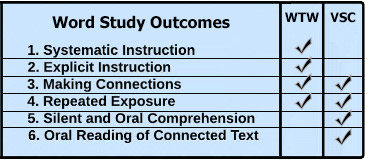Currently the big fights in literacy curriculum have more to do with the increased demands (ie rigor) of the Common Core and how the heck to teach it. Schools are struggling to develop skills at teaching close reading and the ability to do sophisticated synthesis and comparisons between two or even three informational texts.
But in the background, there remains some big disagreements on the role of curriculum, standards, and technology. Some people still believe in and rely on the classic basal readers which provide a recipe and all the materials for each grade level. Reading Street, Journeys, and Wonders reign as leading reading programs. An alternative approach which has had great traction across the country is Words Their Way (now it belongs to Pearson) which has students sorting out sounds and cutting them into little pieces.
These are are very traditional programs in terms of delivery so they often get paired with slick modern technology solutions such as VocabularySpellingCity. Here's a success story on the mechanics of combining Words Their Way with VSC and a research study that talks about how the high effectiveness of pairing VSC with WTW:
VocabularySpellingCity is the only resource we've found that has the capacity to be paired with the Words Their Way approach to accomplish the goals of spelling, phonics and vocabulary instruction,” write Nielsen-Winkelman and West. “As educational technologies emerge and evolve, it is essential to use a critical eye toward the specific tool affordances when making decisions about instructional practice.”
The article, “Improving Word Study — Moving Beyond Paper and Pencil to Transformative Educational Technology,” was published in the June 2015 issue of Literacy Special Interest, the Journal of the International Society for Technology in Education’s (ISTE) Literacy Professional Learning Network, in conjunction with the ISTE 2015 Conference.
Creating A Streamlined Process
Nielsen-Winkelman and West identified six key components for phonics, vocabulary and spelling instructional practices and used them to evaluate VocabularySpellingCity (VSC) and Words Their Way (WTW): (1) systematic instruction, (2) explicit/direct instruction, (3) making connections, (4) repeated exposure, (5) comprehension of material read silently or orally, and (6) oral reading of connected text.
Nielsen-Winkelman and West identified six key components for phonics, vocabulary and spelling instructional practices and used them to evaluate VocabularySpellingCity (VSC) and Words Their Way (WTW): (1) systematic instruction, (2) explicit/direct instruction, (3) making connections, (4) repeated exposure, (5) comprehension of material read silently or orally, and (6) oral reading of connected text.

Credit: Nielsen-Winkelman, Tiffany and West, Lynnea
No comments:
Post a Comment